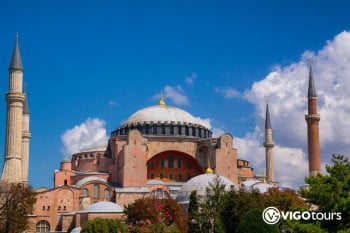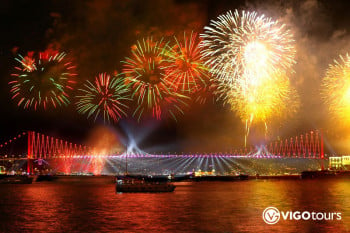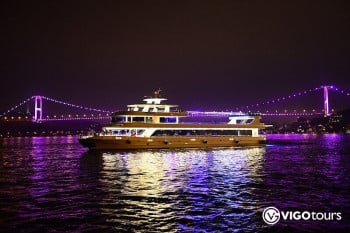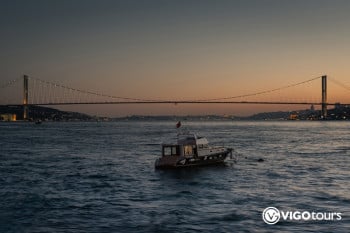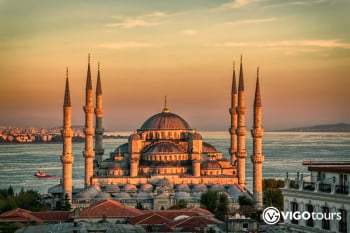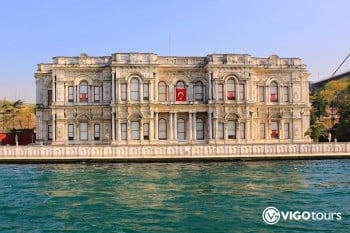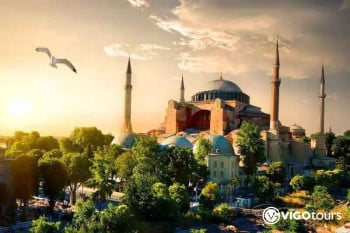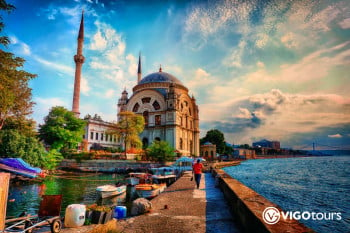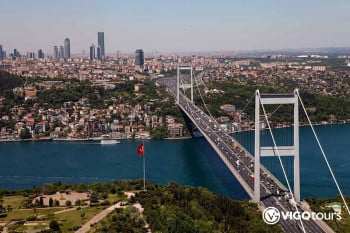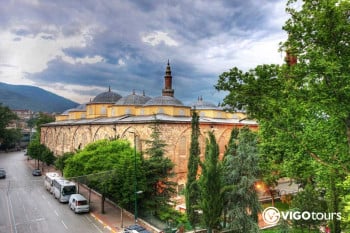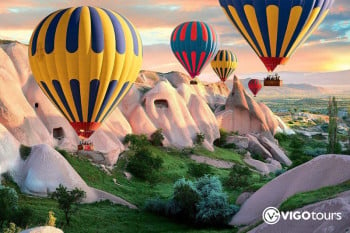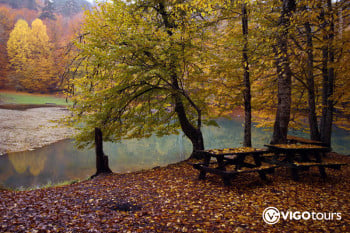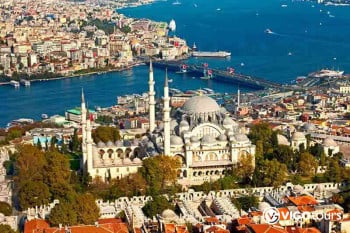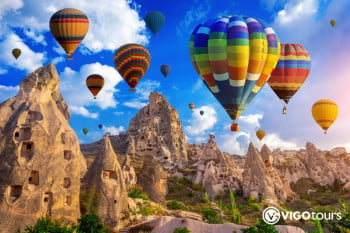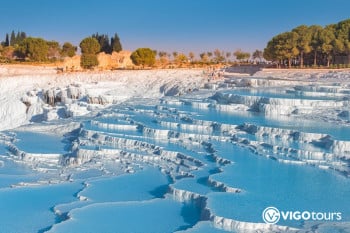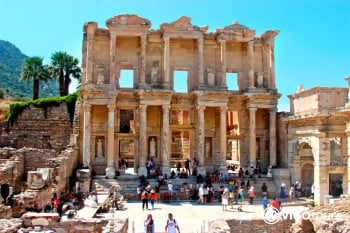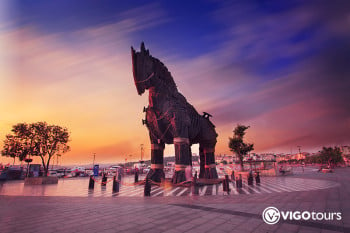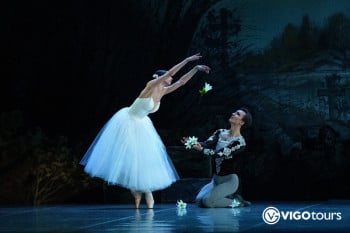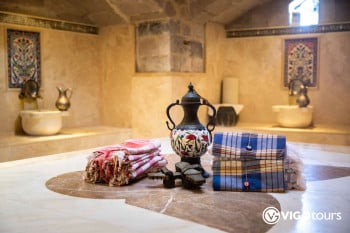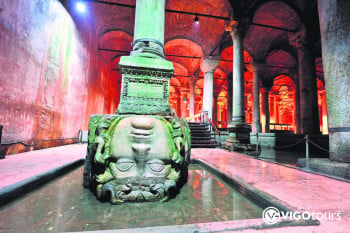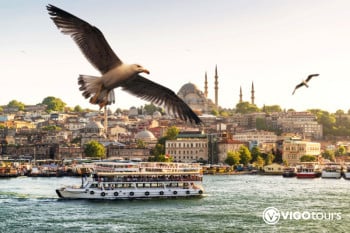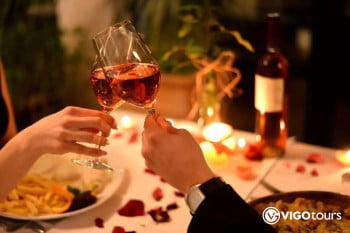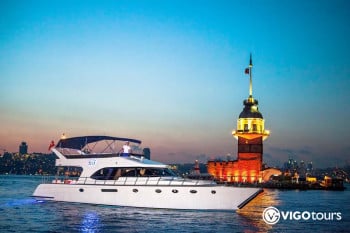Istanbul Tours, Cruises and Cultural Experiences
Istanbul is a city shaped by empires, continents, and centuries of history. From world-famous landmarks and scenic Bosphorus cruises to cultural journeys beyond the city, Istanbul offers experiences that appeal to every traveler. The tours listed below are carefully organized to help visitors explore the city comfortably, meaningfully, and with professional guidance, whether it is a first visit or a return journey.
Explore the best daily tours and activities in Istanbul with professional guides, comfortable transportation, and well-planned itineraries. From historic city tours and Bosphorus cruises to cultural experiences and day trips beyond the city, these activities are designed to help travelers discover Istanbul with ease and confidence.
Best Istanbul Daily Tours with Hotel Pickup
Istanbul daily tours with hotel pickup offer a convenient way to explore the city without worrying about transportation or planning. These tours combine professional guiding, comfortable transfers, and efficient schedules, making them ideal for visitors who want to see Istanbul’s highlights in an organized and stress-free way.
Affordable and Family-Friendly Istanbul Tours
Many Istanbul tours are suitable for families, couples, and first-time visitors. Options such as Bosphorus cruises, guided city tours, cultural shows, and food experiences are designed to provide good value, comfort, and enjoyable exploration for travelers of all ages.
Guided City Tours and Historical Experiences in Istanbul
Guided city tours focus on Istanbul’s rich Byzantine and Ottoman heritage, including landmarks such as Hagia Sophia, Topkapi Palace, the Blue Mosque, the Basilica Cistern, and the Grand Bazaar. Professional licensed guides help visitors understand the city’s layered history while keeping the experience clear and engaging.
Bosphorus Cruises and Sea Experiences
Bosphorus cruises are among the most popular experiences in Istanbul, offering panoramic views between Europe and Asia. From sightseeing cruises to dinner cruises with entertainment, these tours provide a relaxed way to enjoy Istanbul’s skyline, waterfront palaces, bridges, and evening atmosphere from the water.
Day Trips from Istanbul
Istanbul is also an excellent starting point for well-organized day trips and short tours beyond the city. Popular destinations include Bursa, Sapanca and Maşukiye, Troy, Gallipoli, and flight-based trips to Pamukkale or Ephesus. These tours allow travelers to experience more of Turkey without changing hotels.
Hagia Sophia Ticket Sales Point
Easy and Organized Access to Hagia Sophia
Save Time at One of Istanbul’s Most Visited Landmarks
Hagia Sophia is one of the most iconic monuments in the world and attracts a very high number of visitors every day. Using the Hagia Sophia ticket sales point allows travelers to plan their visit more efficiently and avoid unnecessary waiting times, especially during busy seasons. This service is ideal for visitors who want a smooth and organized entry experience, giving them more time to admire the architectural grandeur, ancient mosaics and the unique blend of Byzantine and Ottoman history that defines Hagia Sophia.
New Year’s Eve Dinner Cruise Party on the Bosphorus
Welcome the New Year Between Two Continents
A Festive Night with Dinner, Music and City Lights
Celebrating New Year’s Eve on the Bosphorus is one of the most unforgettable ways to welcome the new year in Istanbul. The New Year’s Eve dinner cruise party on the Bosphorus combines a festive atmosphere, carefully prepared dinner menus, live entertainment and panoramic views of Istanbul’s illuminated skyline. Sailing between Europe and Asia while enjoying music and celebration creates a unique setting that cannot be experienced anywhere else in the city.
Bosphorus Dinner Cruise
Discover Istanbul by Night from the Water
Dining, Views and Entertainment Combined
A Bosphorus dinner cruise offers a relaxing and elegant way to experience Istanbul after sunset. During the Bosphorus dinner cruise, guests enjoy a full dinner while passing historic palaces, bridges and waterfront mansions beautifully illuminated along the shoreline. This experience is especially popular among couples and first-time visitors, as it combines local cuisine, entertainment and unforgettable night views of the city in a comfortable and enjoyable setting.
Fishing Tour in the Bosphorus of Istanbul
A Different Side of Istanbul on the Sea
Fish in One of the World’s Most Famous Straits
The fishing tour in the Bosphorus of Istanbul offers a unique opportunity to experience the city from a completely different perspective. Guided by experienced local fishermen and using professional equipment, participants fish in the Bosphorus while enjoying peaceful moments on the water. This tour is suitable for both beginners and experienced anglers and allows visitors to combine relaxation, local tradition and spectacular city views in one activity.
Topkapi Palace, Hagia Sophia and More Istanbul City Tour
Explore the Imperial Center of Istanbul
A Full Day of History and Culture
This comprehensive city tour is designed for travelers who want to understand Istanbul’s historical importance in a single day. The Topkapi Palace, Hagia Sophia and more Istanbul city tour includes visits to major imperial landmarks, where professional guides explain the political, religious and cultural significance of each site. It is an ideal choice for first-time visitors seeking a structured and informative introduction to the city.
Beylerbeyi Palace Half Day Afternoon Tour
An Elegant Ottoman Palace on the Asian Side
History with a Bosphorus View
Located on the Asian shore of the Bosphorus, Beylerbeyi Palace is a refined example of late Ottoman architecture. The Beylerbeyi Palace half day afternoon tour allows visitors to explore the palace’s elegant interiors, gardens and historical significance in a relaxed afternoon program. This tour is perfect for travelers who want to see an important yet less crowded landmark while enjoying scenic views along the Bosphorus.
Istanbul Byzantine Relics Half Day Morning Tour
Discover the Ancient Roots of Constantinople
A Focused Journey into Byzantine History
The Istanbul Byzantine relics half day morning tour is ideal for travelers who want to explore the city’s early history before the Ottoman era. This guided experience focuses on monuments, churches and archaeological remains from the Roman and Byzantine periods. With detailed explanations from a professional guide, visitors gain a deeper understanding of how Constantinople became one of the most important cities of the ancient world, all within a well-paced morning itinerary.
Istanbul City Tour with Bosphorus Cruise and Dolmabahce Palace
From Imperial Grandeur to Scenic Waters
A Balanced Experience by Land and Sea
Combining cultural exploration with panoramic views, the Istanbul city tour with Bosphorus cruise and Dolmabahce Palace offers a well-rounded look at the city. Visitors explore Dolmabahce Palace, the symbol of the late Ottoman period, and then enjoy a relaxing Bosphorus cruise. This tour is perfect for those who want to experience Istanbul’s architectural elegance and natural beauty in one carefully planned day.
Bosphorus Istanbul Asia and Europe Full Day Tour
Experience Two Continents in One City
A Complete Overview of Istanbul
The Bosphorus Istanbul Asia and Europe full day tour is designed for travelers who want to see both sides of Istanbul in a single day. With guided visits to key locations, scenic viewpoints and cultural highlights, this tour offers insight into how the city developed across two continents. It is especially suitable for first-time visitors who want a broad yet meaningful introduction to Istanbul’s geography and lifestyle.
Istanbul Ottoman Relics Afternoon Half Day Tour
Explore the Ottoman Legacy of Istanbul
Mosques, Complexes and Imperial History
The Istanbul Ottoman relics afternoon half day tour focuses on the architectural and cultural heritage left by the Ottoman Empire. Guided visits to significant mosques and historical complexes allow visitors to understand how Ottoman traditions shaped the city. This afternoon tour is ideal for travelers who want a deeper cultural experience without committing to a full-day program.
Day Trip from Istanbul to Bursa
Visit the First Capital of the Ottoman Empire
History, Nature and Local Culture
The day trip from Istanbul to Bursa offers a refreshing change of scenery and a journey into early Ottoman history. Bursa is known for its historic mosques, traditional markets and natural surroundings. This tour is well suited for visitors who want to combine cultural exploration with a more relaxed atmosphere outside Istanbul, all within a single day.
2-Day Trip to Cappadocia from Istanbul
Discover One of Turkey’s Most Unique Regions
Fairy Chimneys, Valleys and Ancient Sites
The 2-day trip to Cappadocia from Istanbul allows travelers to experience one of Turkey’s most extraordinary landscapes in a short time. With its surreal rock formations, underground cities and panoramic viewpoints, Cappadocia offers a completely different atmosphere from Istanbul. This tour is ideal for visitors who want to see more of Turkey without extending their stay significantly.
Sapanca Lake and Masukiye Village Tour from Istanbul
Escape the City into Nature
Lakes, Forests and a Relaxing Atmosphere
The Sapanca Lake and Masukiye Village tour from Istanbul is a perfect option for travelers who want to take a break from the busy city environment. Surrounded by green landscapes, peaceful lake views and small village life, this tour offers a refreshing change of pace. Visitors enjoy natural scenery, fresh air and local surroundings, making it an excellent choice for families and nature lovers looking for a calm day outside Istanbul.
Half Day Suleymaniye Mosque and Yedikule Fortress Tour
Discover Istanbul’s Less Crowded Historical Sites
Architecture, Faith and City Walls
The half day Suleymaniye Mosque and Yedikule Fortress tour focuses on two historically important yet quieter landmarks. Suleymaniye Mosque, designed by Mimar Sinan, represents the height of Ottoman architecture, while Yedikule Fortress offers insight into Istanbul’s ancient defensive walls. This guided tour is ideal for visitors interested in architecture, history and a deeper understanding of the city beyond the main tourist routes.
Suleymaniye Mosque, Yedikule Fortress and Bosphorus Tour
A Full Day of Culture and Scenic Views
History on Land, Beauty on Water
The Suleymaniye Mosque, Yedikule Fortress and Bosphorus tour combines cultural exploration with a relaxing cruise experience. After visiting major historical landmarks, guests enjoy a Bosphorus cruise that reveals Istanbul’s skyline from the sea. This tour is perfect for travelers who want to balance historical discovery with scenic relaxation in a single day.
Istanbul Gallipoli Full Day Tour
A Powerful Journey into Modern History
Battlefields, Memorials and Stories
The Istanbul Gallipoli full day tour offers a meaningful and educational experience focused on World War I history. Visitors explore significant battlefields, memorials and cemeteries while learning about the events that shaped the region. This tour is especially important for travelers interested in military history and those who want to understand the historical significance of Gallipoli beyond textbooks.
Istanbul Cappadocia Pamukkale Ephesus 4-Day Tour
Explore Turkey’s Most Famous Destinations
History, Nature and Ancient Civilizations
The Istanbul Cappadocia Pamukkale Ephesus 4-day tour is designed for travelers who want to experience Turkey’s highlights in a short timeframe. From the surreal landscapes of Cappadocia to the white travertines of Pamukkale and the ancient ruins of Ephesus, this tour offers a comprehensive journey through Turkey’s cultural and natural heritage with professional organization.
Pamukkale Tour from Istanbul by Plane
Fast Access to One of Turkey’s Natural Wonders
Comfort and Efficiency Combined
The Pamukkale tour from Istanbul by plane is ideal for travelers with limited time who still want to see one of Turkey’s most iconic destinations. Flying directly allows visitors to avoid long road travel while enjoying Pamukkale’s famous white terraces and the ancient city of Hierapolis. This tour offers a comfortable and well-planned way to experience both nature and history in a single day.
Ephesus and Virgin Mary’s House Tour by Plane
Discover Ancient Ephesus in One Day
History, Archaeology and Spiritual Heritage
The Ephesus and Virgin Mary’s House tour by plane is designed for travelers who want to explore one of the best-preserved ancient cities in the world without long road travel. Flying from Istanbul allows visitors to maximize their time at Ephesus, where monumental structures such as the Library of Celsus and the Great Theatre reveal the grandeur of Roman civilization. The visit to the House of Virgin Mary adds a spiritual dimension, making this tour both culturally and emotionally meaningful.
Troy and Gallipoli ANZAC 2-Day Tour from Istanbul
From Legendary Myths to Modern History
Two UNESCO-Level Experiences Combined
The Troy and Gallipoli ANZAC 2-day tour from Istanbul offers a powerful journey through two of Turkey’s most historically significant regions. Visitors explore the legendary ruins of ancient Troy, known from Homer’s epics, before continuing to the Gallipoli Peninsula, where key events of World War I took place. This carefully structured tour provides historical depth, expert guidance and emotional insight into both ancient mythology and modern history.
Day Trip to Troy from Istanbul
Walk Through the World of Ancient Legends
Archaeology and Mythology in One Site
The day trip to Troy from Istanbul is ideal for travelers interested in ancient civilizations and classical mythology. Troy’s layered archaeological structure reveals thousands of years of settlement, warfare and legend. Guided explanations help visitors understand the historical significance of the site beyond the famous Trojan Horse story. This tour is a rewarding cultural experience for history lovers who want to explore an iconic destination in a single day.
Guided Foodie Tour on Istanbul’s European and Asian Sides
Taste the City Like a Local
Culinary Culture Across Two Continents
The guided foodie tour on Istanbul’s European and Asian sides offers an authentic introduction to Istanbul’s diverse food culture. Participants sample traditional dishes, street food and regional flavors while exploring neighborhoods on both sides of the Bosphorus. This tour goes beyond typical sightseeing by connecting visitors with local tastes, stories and daily life, making it a perfect choice for travelers who want to experience Istanbul through its cuisine.
Tickets for Opera and Ballet Events in Istanbul
Experience Istanbul’s Artistic Side
World-Class Performances in Historic Venues
Istanbul is not only rich in history but also vibrant in performing arts. With tickets for opera and ballet events in Istanbul, visitors can enjoy high-quality productions in elegant venues. Attending an opera or ballet performance adds a refined cultural layer to any Istanbul visit and offers a memorable evening beyond traditional sightseeing activities.
Private Turkish Bath, Sauna and Massage Experience
Relax with an Ancient Wellness Tradition
Privacy, Comfort and Deep Relaxation
The private Turkish bath, sauna and massage experience provides a personalized approach to one of Turkey’s most famous traditions. Guests enjoy a private setting that includes steam, exfoliation and massage treatments inspired by centuries-old rituals. This experience is ideal for travelers who want to relax after sightseeing while connecting with an authentic aspect of Ottoman culture.
Istanbul Basilica Cistern Skip-the-Line Guided Tour Experience
Discover the Underground Wonder of Istanbul
Fast Entry with Expert Interpretation
The Istanbul Basilica Cistern skip-the-line guided tour experience offers visitors the opportunity to explore one of the most atmospheric landmarks of the city without waiting in long lines. Located beneath the historic peninsula, the Basilica Cistern reveals ancient columns, mysterious lighting and legendary elements such as the Medusa heads. With professional guide explanations, visitors gain a deeper understanding of Byzantine engineering, water systems and the historical importance of this underground structure.
Imperial and Hidden Treasures of Istanbul
Go Beyond the Classic Tourist Routes
Secrets, Stories and Forgotten Landmarks
The Imperial and hidden treasures of Istanbul tour is designed for travelers who want to discover the city beyond its well-known highlights. This experience focuses on lesser-visited historical sites, hidden courtyards and overlooked architectural details that reveal Istanbul’s imperial past. Guided storytelling connects these locations with fascinating historical narratives, making this tour ideal for visitors seeking a deeper and more authentic understanding of the city.
Istanbul Princes’ Islands Tour
A Peaceful Escape from Urban Life
Island Views, Fresh Air and Slow Travel
The Istanbul Princes’ Islands tour offers a refreshing contrast to the busy city atmosphere. After a scenic ferry ride, visitors explore charming island streets, historic mansions and coastal scenery at a relaxed pace. The islands are known for their calm environment, making this tour ideal for travelers who want to enjoy nature, sea views and a slower rhythm while still remaining close to Istanbul.
Valentine’s Day Bosphorus Dinner Cruise with Drinks Included
Celebrate Love on the Bosphorus
A Romantic Evening with Iconic Views
The Valentine’s Day Bosphorus dinner cruise with drinks included is designed for couples looking to celebrate a special occasion in a memorable setting. Sailing along the Bosphorus at night, guests enjoy a romantic dinner, drinks and panoramic views of Istanbul’s illuminated skyline. This experience combines elegance, intimacy and atmosphere, making it one of the most popular choices for Valentine’s Day in Istanbul.
Private Yacht Organization in Istanbul Bosphorus
A Fully Personalized Bosphorus Experience
Luxury, Privacy and Flexibility
The private yacht organization in Istanbul Bosphorus offers the highest level of comfort and exclusivity on the water. Ideal for private celebrations, proposals, corporate events or relaxed sightseeing, this experience allows guests to design their own itinerary along the Bosphorus. With uninterrupted views, personalized service and complete privacy, a private yacht cruise delivers an unforgettable way to experience Istanbul from the sea.
Frequently Asked Questions About Istanbul Tours and Experiences
What is the best tour for first-time visitors to Istanbul?
For first-time visitors, city tours that include Hagia Sophia, Topkapi Palace and a Bosphorus cruise are the best choice. These tours provide a clear overview of Istanbul’s history, culture and geography in a well-organized format.
How long does a Bosphorus cruise usually last?
Most Bosphorus cruises last between two and four hours, depending on whether they include dinner, entertainment or sightseeing only. Evening dinner cruises tend to be longer than daytime cruises.
Is a guided tour necessary in Istanbul?
While it is possible to explore Istanbul independently, guided tours add significant value. Professional guides help visitors understand historical context, architecture and cultural details that might otherwise be missed.
When is the best time of year to visit Istanbul?
Istanbul can be visited year-round, but spring and autumn are considered the most pleasant seasons. During these months, weather conditions are ideal for sightseeing and outdoor activities.
Are Istanbul tours suitable for families?
Many Istanbul tours are family-friendly and suitable for children. Boat tours, island trips and cultural experiences offer relaxed programs that families can enjoy together.
Can I visit both Europe and Asia in one day in Istanbul?
Yes, Istanbul is unique in allowing visitors to experience two continents in one day. Full-day tours covering both the European and Asian sides make this possible in a comfortable and organized way.
Do Bosphorus dinner cruises include entertainment?
Most Bosphorus dinner cruises include live entertainment such as traditional music, dance performances or cultural shows, creating a lively and memorable evening atmosphere.
Is Hagia Sophia crowded during the day?
Hagia Sophia is one of the most visited landmarks in Istanbul and can be very crowded, especially during peak hours. Early visits or organized entry services help reduce waiting time.
Are day trips from Istanbul worth it?
Day trips to destinations like Bursa, Sapanca or Troy are highly worthwhile for travelers who want to see more of Turkey without changing hotels. These trips add variety to an Istanbul itinerary.
How physically demanding are Istanbul tours?
Most Istanbul tours involve moderate walking. Comfortable shoes are recommended, especially for historical areas with uneven surfaces and large sites like palaces or old city districts.
Can I explore Istanbul at night?
Yes, Istanbul offers many evening experiences such as Bosphorus dinner cruises, cultural performances and night city views. These activities show a different side of the city after sunset.
Is the Princes’ Islands tour a relaxing experience?
The Princes’ Islands tour is known for its calm and peaceful atmosphere. It is ideal for visitors who want a break from city traffic and crowds while enjoying nature and sea views.
Are multi-day tours from Istanbul well organized?
Multi-day tours departing from Istanbul are professionally planned and include transportation, accommodation and guided visits. They are ideal for travelers who want to see major destinations efficiently.
What makes Cappadocia tours from Istanbul popular?
Cappadocia tours are popular due to the region’s unique landscapes, fairy chimneys and historical sites. Flying from Istanbul makes it possible to experience this area in a short time.
Is Pamukkale accessible as a day trip from Istanbul?
Pamukkale can be visited as a day trip from Istanbul by plane. This option allows travelers to see the famous white terraces and ancient ruins without long travel times.
Are food tours in Istanbul suitable for all tastes?
Food tours in Istanbul are designed to introduce a variety of local flavors. They usually include options that appeal to different tastes, making them suitable for most visitors.
Can I attend cultural events like opera or ballet in Istanbul?
Istanbul has an active cultural scene with opera and ballet performances held throughout the year. These events are a great way to experience the city’s artistic side.
Is a Turkish bath experience suitable for tourists?
A Turkish bath is one of the most popular cultural experiences for visitors. It offers relaxation while introducing an important tradition of Ottoman and Turkish culture.
Are skip-the-line tours useful in Istanbul?
Skip-the-line tours are especially useful at popular attractions like the Basilica Cistern. They save time and allow visitors to focus more on the experience itself.
Do I need to book Istanbul tours in advance?
Booking in advance is recommended, particularly during high season. Early reservations help secure availability and allow better planning of your travel schedule.

